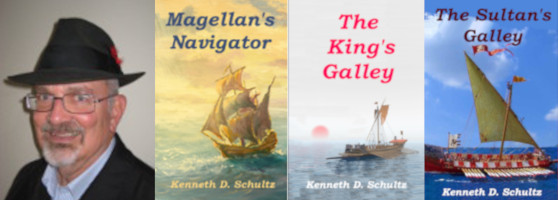Magellan took thirty-eight days in all to transit the “Strait of Magellan.” His time there was blessed by unusually good weather, but complicated by the search for the San Antonio after its defection.
While the Victoria searched for the wayward San Antonio, Magellan’s Trinidad and the Concepcion anchored in the sheltered ‘Bay of Sardines.’ There they made repairs, netted, not surprisingly, sardines, and some ate the watercress like vegetation that grew in the streams entering the bay.
Magellan knew there was another sea or ocean to the west of the Americas. On September 25, 1513 Balboa was the first European to see it from a mountain on the Isthmus of Panama. He later waded in its waters and claimed it for Spain as the “South Sea.” However, no European knew its true extent. Magellan seems to have thought the Spice Islands were a short two to three-week sail to the west.
While waiting for the Victoria, Magellan sent a shallop to explore the maze of fjord-like waterways to the west. On the shallop were a Flemish gunner, Roldan de Argot, Bocacio Alonso, a seaman, and Hernando de Bustamente, the surgeon barber. (Interestingly, all three of these men would eventually make it back to Spain.)
The shallop returned some days later. Roldan de Argot announced that there was an ocean to the west. He had climbed a mountain peak and only seen open water to the northwest. What he probably saw was the Ocean Reach, an over twenty-mile wide and sixty-mile long fjord that does end at the Pacific Ocean.
Magellan rejoiced. All he’d work towards was finally coming to be. After rendezvousing with the Victoria, on November 21, 1520 he sent a notarized order to the captains, masters, pilots, and mates of the armada, asking their opinions on how they should proceed. Of course, at the time Magellan’s main adversaries had either left on the San Antonio, been marooned, or executed. In this order, Magellan pointedly says that he is “a man who never scorns the opinion and counsel of anyone.” And despite the executions at San Julian “you need not be afraid, for all that happened was done in the service of His Majesty, and for the security of his fleet.” What went through the officers’ minds? I wouldn’t have wanted to be on Magellan’s ‘bad’ list. Not surprisingly all the officers agreed to proceed.
The small fleet then sailed on November 26 and actually entered the Pacific Ocean on November 28, 1520.
My next blog will discuss Magellan’s sail across the Pacific. This didn’t take weeks. The three ships wouldn’t see Guam, their first landfall, until March 6, 1521. By this time the crews would be wracked by scurvy and starvation. Despite the longer than expected transit, fewer lives would have been lost had the stores aboard the San Antonio been available, and had weeks not been wasted in search of the San Antonio.
The Strait of Magellan would never be a common passage for ships. It is simply too tortuous and dangerous in the stormy weather that often prevails there. Most ships sail further south around Cape Horn.
